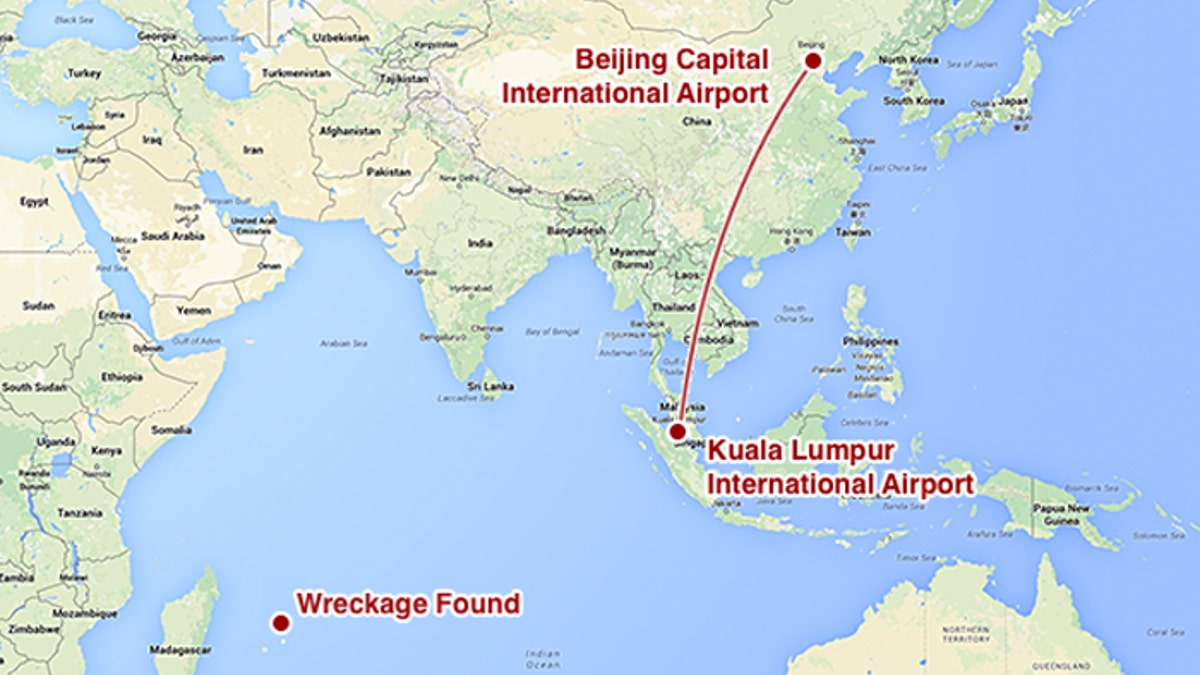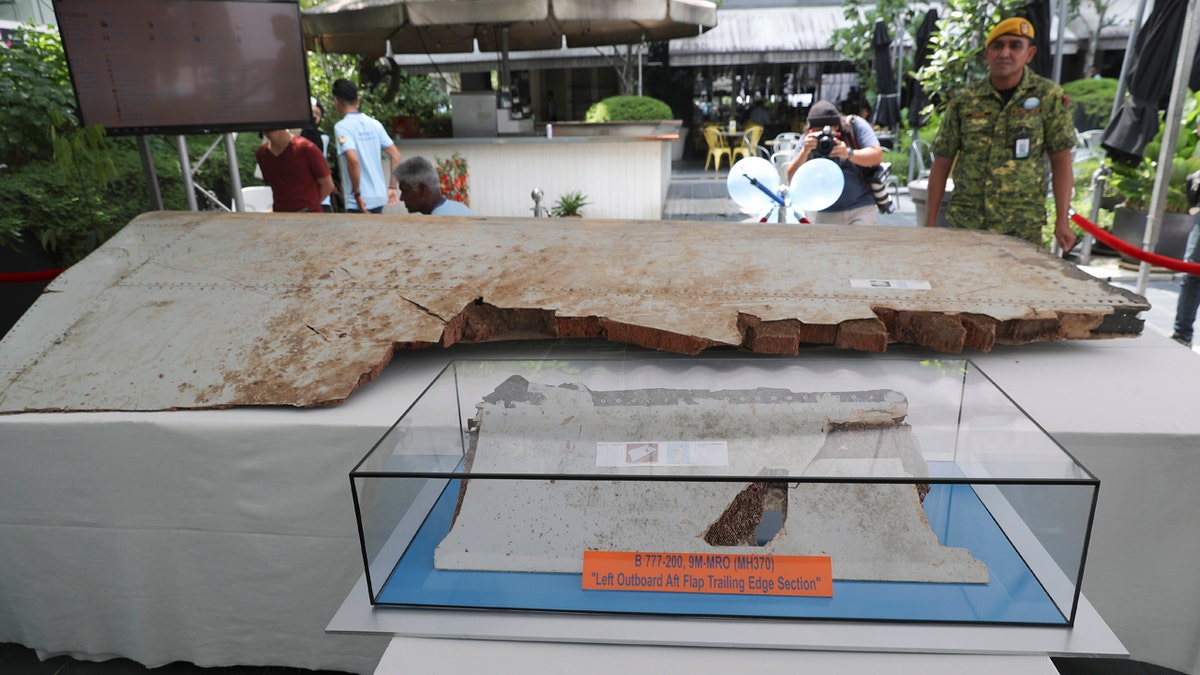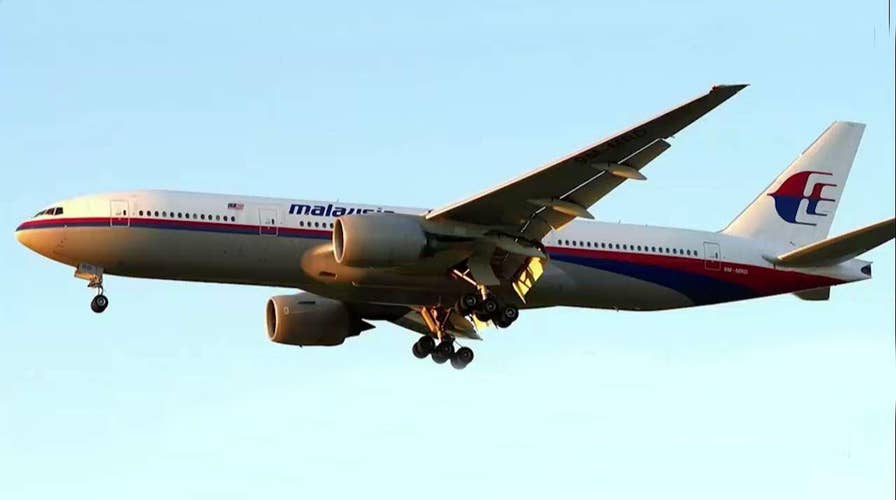Whatever happened to Malaysia Airlines Flight 370?
A Houston company is finalizing a contract with the Malaysian government to resume the search; Doug McKelway takes a closer look for 'Special Report.'
The ill-fated Malaysia Airlines Flight 370 was piloted by a "lonely and sad" captain who experimented with a flight profile almost identical to the aircraft's final doomed path -- one that left a slim chance of finding remains or clues to what really happened in the skies that calamitous evening, a new report reveals.
In the July issue of The Atlantic, writer and aviation specialist William Langewiesche delves into what happened to the missing aircraft, including the disclosure that Malaysian officials knew far more about where the aircraft was the night it went missing and that Captain Zaharie Ahmad Shah had "indications of trouble."
The Boeing 777 carrying 239 people from Kuala Lumpur to Beijing vanished March 8, 2014, and is presumed to have crashed in the far southern Indian Ocean. A safety report into the disaster by an international team last July revealed the plane was likely steered off course deliberately by someone and flown for several hours after communications were severed.
MALAYSIA OPEN TO PROPOSALS TO RESUME MH370 HUNT 5 YEARS AFTER MYSTERIOUS DISAPPEARANCE
The night the aircraft went missing, control was seized in the cockpit during a 20 minute period between 1:01 a.m. and 1:21 a.m. and radar records show the autopilot was probably switched off, according to Langewiesche.

Debris from the missing Malaysia Airlines Flight MH370 is displayed during a Day of Remembrance for MH370 event in Kuala Lumpur, Malaysia, Sunday, March 3, 2019. (AP Photo/Vincent Thian)
The Boeing 777 then made a tight turn to the southwest that Mike Exner, an electrical engineer and investigating the disaster as a member of Independent Group, told The Atlantic probably coincided with a climb of up to 40,000 feet meant to "accelerate the effects of depressurizing the airplane, causing the rapid incapacitation and death of everyone in the cabin."
While drop-down oxygen masks may have deployed, passengers would have had little use since they are only intended for 15 minutes of use during emergency descents, not cruising at high altitudes. Whoever was in the cockpit, however, would have had access to four pressurized-oxygen masks with a supply that could last hours.
"The cabin occupants would have become incapacitated within a couple of minutes, lost consciousness, and gently died without any choking or gasping for air," Langewiesche writes.

This map shows the intended route of MH370 and the area that plane debris was found in September 2018. MH370 was less than an hour into its flight from Kuala Lumpur to Beijing when it disappeared from radar. Investigators believe it veered off course and went missing somewhere in the southern Indian Ocean.
As MH370 kept rocking across the sky, the aircraft appeared on radar while approaching Penang island at nearly 600 mph where the Malaysia air force had F-18 interceptors stationed at Butterwoth Air Base. A former official told the Atlantic that air force officials made sure an accident report was edited last year to say the radar had been "actively monitored" and the aircraft was not intercepted since it was "friendly."
That appears to be far from the truth. Military officials initially searched for MH370 in the wrong body of water to the east, when the aircraft actually flew in the opposite direction.
DEBRIS OFF MADAGASCAR 'MOST LIKELY' FROM MALAYSIA AIRLINES FLIGHT 370, REPORT SAYS
When the report by a 19-member international team was released last July, Chief investigator Kok Soo Chon said during a media briefing there was no evidence of abnormal behavior or stress among the two pilots – Capt. Zaharie Ahmad Shah and co-pilot, Fariq Abdul Hamid – that could lead them to hijack the plane.

MH370 Captain Zaharie Ahmad Shah was often "lonely and sad," and had experimented with a flight profile similar to that of the missing plane, according to a new report. (Facebook)
Langewiesche notes that while the co-pilot had nothing but a bright future ahead and no red flags in his past, Zaharie's life raised multiple concerns. After his wife moved out, the captain, who was reported to be "lonely and sad," also "spent a lot of time pacing empty rooms" and obsessed over two young internet models.
Forensic examinations of the pilot's simulator by the FBI also revealed he experimented with a flight profile that roughly matched what's believed to have happened to MH370, and that ended in "fuel exhaustion over the Indian Ocean." New York Magazine reported in 2016 that the simulated flight was conducted less than a month before the plane vanished.
A fellow 777 captain who wished to not be identified out of fear of repercussions did not offer a possible motive to The Atlantic, but said Zaharie's emotional state was fragile.
"Zaharie’s marriage was bad. In the past he slept with some of the flight attendants. And so what? We all do," the pilot told the magazine. "You’re flying all over the world with these beautiful girls in the back. But his wife knew."
While Langewiesche notes the idea of "a pilot who runs amok" may be hard to conceive, it has happened before. In a similar incident, EgyptAir Flight 990 crashed off the coast of Massachusetts in October 1999 on its way from John F. Kennedy Airport in New York to Cairo. Audio captured by the co-pilot caught pilot Gameel Al-Batouti say 11 times in Arabic, “I rely on God.”
Two years later, the National Transportation Safety Board determined Al-Batouti had been suicidal and purposely crashed the plane while the first pilot was out of the cockpit. Egyptian Civil Aviation Agency adamantly denied the NTSB’s findings, saying the report was “flawed and biased.”
The doomed Germanwings Flight 9525, which crashed into the French Alps in 2015, was also determined to be a case of suicide-by-pilot. Officials determined co-pilot Andreas Lubitz, who had previously been treated for suicidal tendencies, flew the airliner into the mountains on purpose. The plane was heading to Dusseldorf Airport in Germany from Spain.
CLICK HERE FOR THE FOX NEWS APP
Malaysia's government has said that investigative reports released thus far are not a final accounting because the plane's wreckage or so-called black boxes haven't been found. But even when -- or if -- they are discovered, Langewiesche writes that it may "accomplish little" since the cockpit voice recorder self-erases after a two-hour loop and probably only has the sounds of the final alarms going off.

Debris from the missing Malaysia Airlines Flight MH370 is displayed during a Day of Remembrance for MH370 event in Kuala Lumpur, Malaysia, Sunday, March 3, 2019. Five years ago, Flight MH370, a Boeing 777, had gone missing the day before while over the South China Sea with 239 people on board. (AP Photo/Vincent Thian) (AP Photo/Vincent Thian)
The flight-data recorder may show when the aircraft was depressurized and how the satellite box was powered down, but give no further explanation as to what happened in the cockpit.
Scattered pieces of debris that washed ashore on African beaches and Indian Ocean islands indicate MH370 crashed in a distant stretch of the ocean, but a multi-government search by Australia, Malaysia and China failed to pinpoint a location.
Additional debris, however, may take a while to locate since the aircraft is believed to have gone into a "vicious spiral" before colliding with the sea in a manner in which the plane "disintegrated into confetti when it hit the water," according to Langewiesche.
Instead of focusing on finding the physical parts of the Boeing 777, the aviation expert believes some of the key parts of the timeline of what happened could be revealed by what authorities in Malaysia know and are keeping from the public.
"Unless they are as incompetent as the air force and air traffic control, the Malaysian police know more than they have dared to say," Langewiesche notes. "The riddle may not be deep."
Fox News' Ryan Gaydos and The Associated Press contributed to this report.




















